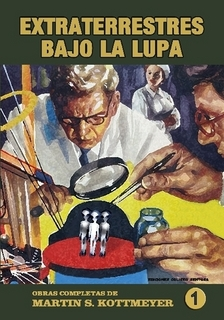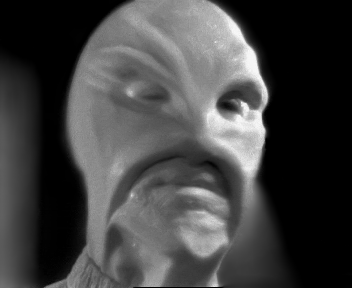Complete works of Martin S. Kottmeyer Volume 1: Extraterrestrial Under Scrutiny.
Translation by: Luis R. González Manso
Sentosa Publishing House, Santiago de Chile, 2020(http://www.lulu.com/spotlight/lanavedeloslocos.)
376 pages.
ISBN: 978-0-244-54649-6
can be purchased at: https://bit.ly/2IQgwiY

I have been away from the literature that studies the UFO phenomenon for many years. Normally the books of the supporters of the extraterrestrial hypothesis (HET) bore me, since the usual thing is that they return to talk about the classic cases and if they are new they repeat the old stereotypes. When the volume «Aliens under the magnifying glass» (Exterterrestres bajo la lupa) fell into my hands, as soon as I started reading I was not bored at all. There are no new cases. In fact, it’s about the oldest sightings, those that gave rise to the UFO myth. The first of those dissected under his magnifying glass is that of Kenneth Arnold (i), who, for most specialists, was the case that marked the birth of the era of UFOs. Let us briefly recall what happened in 1947 and that Arnold was piloting a light aircraft near Mount Rainier, a stratovolcano located southeast of Seattle in the US state of Washington. He saw nine objects moving in concert at high speed. To explain their movement (not their shape) he said they moved «like saucers skipping on water» (like saucers bouncing in water). Despite the fact that Arnold said the objects were shaped like a boomerang, the journalist he spoke to – Bill Baquette – confused the shape with the way of moving and broke the news calling them «flying saucers.» That denomination went around the world. Thus, by mistake, the name came about that has become more famous and, without a doubt, has culturally conditioned the way in which many witnesses describe what they see.
Of the Arnold case I had read many things in favor that they were extraterrestrial ships and other things about much more mundane explanations; I believed that nobody could bring me anything essentially new anymore. I was wrong. With amazing meticulousness, Kottmeyer exposes all the hypotheses, both believers and skeptics, and one by one he shows the reasons why they cannot be true. After this denial, he makes his own hypothesis. I must admit that at first it was not only shocking but implausible, but when reading his arguments, the replies and counter-replies, and the bibliographic citations to prestigious magazines with referees that he uses, I have convinced myself that he is probably right: What Arnold saw were birds in formation, probably swans or pelicans.
That thoroughness and attention to detail that he uses with the Arnold case, he does it with a few other classic UFO cases. For example, the sightings of Father Gill and 37 other witnesses, in New Guinea in 1959(ii). Kottmeyer’s explanations are really long, in the book they occupy from page 85 to 164. I advise you to read it.
Some of Kottmeyer’s explanations are surprising, although, once again, reading his arguments, it is easy to be convinced that he is right. One such case is the one that occurred in the summer of 1953 in Medford (iii), Oregon. There were three witnesses. At 10 pm they were driving home and saw three bank-colored creatures «with very soft fur, like satin», similar in shape to the Shmoos (iv) in the Lil ‘Abner comic strip. His surprising and compelling explanation is that «a deer’s butt was mistaken for an alien.»
Kottmeyer in many of his explanations takes into account a subject that I am passionate about: the malleability of memory and that perception is influenced by the culture of the time (v). I insist again that Kottmeyer uses relevant scientific quotes for each of his claims. To illustrate his thinking, I copy a few sentences from the book: ‘The point is that the cultural overlap is unequivocally present in UFO reports. We often see cases of people adding details to images of mundane phenomena: portholes on Venus, domes added to advertising planes, details clearly derived from saucer books »(page 78)…« in the waves of 19th century airships, witnesses added details derived from the balloons of the time »(page 79).
Many, many years ago, let’s say that, in 1972, when I was driving on a Madrid highway, I saw in front of me a shiny object that was moving and moving away from until it disappeared on the horizon. At the time, my explanation was the same that Kottmeyer gives to similar cases: «The sensation of movement can be explained quickly, either by autokinesis or also as an illusion caused by the movement of clouds, the changes in their density» make their luminosity varies and with it they give the sensation of remoteness.
On page 197 he makes an extremely interesting observation: “We tend to forget that HET was not always the favorite theory about flying saucers. In the 1940s and early 1950s, HET was not mentioned. ” On page 237, we can read: «in line with the prevailing suspicions among the population that the saucers were secret weapons in development by some land power …». On page 239 he makes us see that the repetitions in different sightings of certain constants does not demonstrate their reality, but are «attributable to ufological
«It is not uncommon for multiple witness UFO reports to originate from a real stimulus that would have been distorted by the emotions and expectations created around this cultural myth (vi)» (p. 337).
In the same way it is dismantling other classic cases, for example, that of «Incident in Exeter (vii)». To avoid getting too long, I’m not going to give Kottmeyer’s explanation, but I can’t resist quoting the last sentence (page 178): «And so, another classic bites the dust.»
The last case that this first volume deals with is the famous Hill (viii) couple, with which many of us came to believe that the extraterrestrial visits were real. (Yes, I said we arrived. I, mistakenly, came to believe in them). After his careful dissection of each of the details, he gives us an unexpected fact: Barney Hill talks about how the aliens had «enveloping eyes», understanding as they were elongated and oblique and extended to the sides of the face. Kottmeyer discovered that very similar eyes were present in an episode of the television series «Heading to the Unknown», specifically on the 20th of the first season, entitled «The Bellero (ix) Shield», which aired just twelve days before he mentioned them under hypnosis.

Kottmeyer, in his work, shows that he is a great connoisseur of science fiction literature. Many of the heroes he mentions are those that I read in my youth, for example, Flash Gordon. In the episode entitled «Planeta Mongo» in Spanish, a rocket ship appears that for Kottmeyer could play a certain role in what Chiles and Whitted (xi) saw (pp. 225-232). The ships and characters of Flash Gordon resemble those of certain contact cases. Kottmeyer tells us that these stories, including that of the Hill couple, are «an idea whose ideal time to appear is just then» (p. 330).

As I have already said, this is the first volume. At least six others await us, and I say this because in one of the notes it is said that it will be a specific topic in volume 6.
I am looking forward to the arrival of Volume 2 to remember the good old days and continue to enjoy the deep insights and unexpected solutions Kottmeyer provides us.
If I have any criticism to make, it’s that Kottmeyer takes the gullible too seriously. But honestly, I don’t know if it’s a Kottmeyer flaw or mine, since the credulous arguments seem so ridiculous that I don’t even question them anymore. I just laugh at them, and I’m not sure this is the correct posture. Confrontation is essential for the truth to emerge. The discussions that are read in Kottmeyer’s book have made me think of the phrase that ends my book «The Holy Shroud! What a scam! (xii)»: «A good myth never dies», and the aliens, without a doubt, are a good myth. No matter how much evidence is shown that they are mistakes, there is always a group of people who believe in them.
At first I said that the translation is by Luis R. González Manso. I would like to point out several things, the first is that the translation is magnificent. The second is that González’s work goes much further than that of a translator; in fact, if I have not misunderstood, it has been the compiler and, surprisingly, this is the first time that all of Kottmeyer’s works have been offered together. It was not in English but in Spanish, even though the author is from Illinois. And there is a third and important task: the selection of illustrations, which has often required finding the original mentioned in the text.
Thanks to the Coliseo Sentosa publishing house in Santiago de Chile for introducing us to this curious character who is Martin S. Kottmeyer, who can be followed at:https://www.facebook.com/la.wan.3538
Prof. Dr. Félix Ares de Blas
FINAL NOTES
i) Kenneth Arnold in Wikipedia (s.f.). https://es.wikipedia.org/wiki/Kenneth_Arnold (Retrieved on February 15, 2020. The text is in Spanish)
ii) Although from a credulous point of view, a summary of the case can be seen in: «The UFO Incident in Boianai, Papua New Guinea», on the blog «Proyecto Signo». Recovered on March 15 from: https://proyectosigno.com/el-incidente-ovni-de-boianai-papua-nueva-guinea/
iii) Medford Shmoos, en Cryptid Wiki (s. f.). Recovered on March 15 from: https://cryptidz.fandom.com/wiki/Medford_Shmoos
iv) Shmoo, en Wikipedia (s. f.). Recovered on March 15 from: https://en.wikipedia.org/wiki/Shmoo
v) In fact, I wrote an unpublished book on the subject, titled «New Faces for the Old Gods, (Nuevas caras para los viejos dioses)» and I liked the subject so much that I studied criminology, though never examined myself, to learn more about the problems of testimony.
vi) This is our fundamental conclusion in a work of which we are co-authors David G. López and myself and which recently, thanks to the efforts of Vicente-Juan Ballester Olmos, has been uploaded to «Academia», can be seen at this link:https://www.academia.edu/42153967/EL_FENOMENO_OVNI._ANALISIS_DE_30_ANOS_DE_OBSERVACIONES_EN_ESPANA
vii) Fuller, J. G. (1967). Incidente en Exeter. Barcelona, Plaza y Janés.
viii) Fuller, J. G. (1968). El viaje interrumpido. Barcelona. Plaza y Janés
ix) You can see those eyes, on Wikipedia, in the entry titled «The Bellero Shield», at the following URL:https://en.wikipedia.org/wiki/The_Bellero_Shield
x) The image of the rocket ship can be seen at this link, accessed on March 15, 2020: https://fourcolorglasses.files.wordpress.com/2013/04/alex-raymond-streamlined-rocket.jpg
xi) Chiles-Whitted UFO encounter, en Wikipedia (s. f.). Accessed on March 15, 2020 at: https://en.wikipedia.org/wiki/Chiles-Whitted_UFO_encounter
xii) Ares, F. (2006). La sábana santa. ¡Vaya Timo! Pamplona. Editorial Laetoli. Más detalles en: http://www.laetoli.es/vaya-timo/51-la-sabana-santa-vaya-timo-felix-ares-9788493486228.html
Nota texto. Licenciado como

Félix Ares is licensed under a Creative Commons Reconocimiento 3.0 Unported License.
Creado a partir de la obra en viajes.ares.fm.
Contacto con nosotros; el motivo de que no sea una imagen clara es para evitar que los robots la descubran y nos inunden el buzón de basura.

